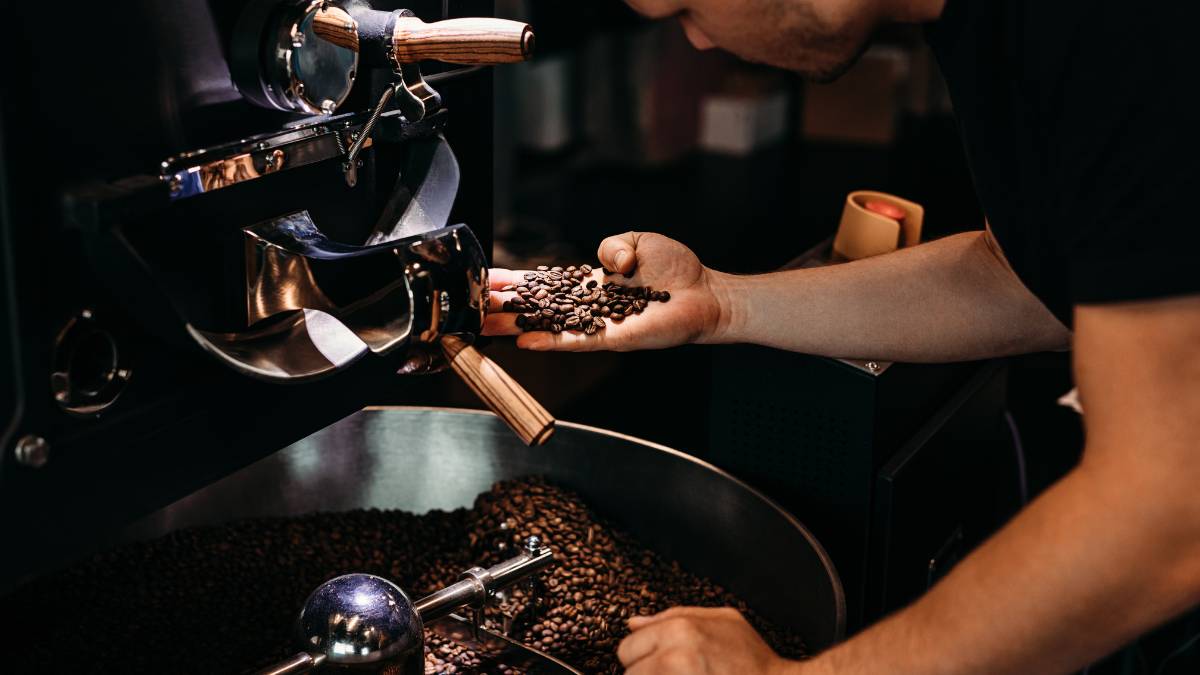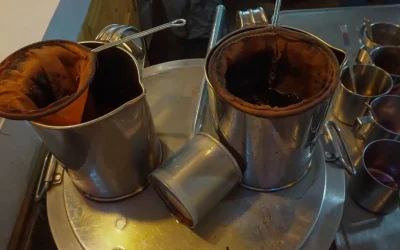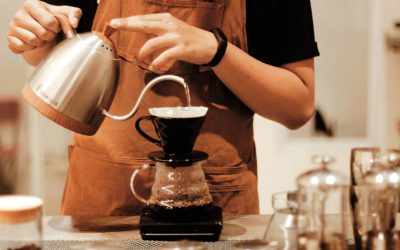How Coffee is Roasted
Whether you roast your own coffee beans or buy coffee from a roaster, it helps to understand the basics of coffee roasting. We’ll introduce some basic terminology and explain the different roast levels.
A roasting process is required to “cook” green coffee beans and expose the natural flavors in the coffee.
Slow Temperature Increase: First, green coffee beans are placed in a roaster and heated. As the roaster heats up, the beans are tumbled like clothes in a dryer to allow the heat to toast the coffee evenly. The temperature is slowly raised to between 460°F and 530°F, allowing heat to penetrate slowly to the center of every coffee bean.
First Color Change: Green coffee beans contain a significant amount of moisture, and you’ll notice the release of a significant amount of steam. As moisture escapes the roasting coffee, the green coffee beans will first turn yellow, then turn brown.
First Crack: When the temperature reaches a critical point, the coffee beans will swell (increase in size) significantly. Soon thereafter, a loud cracking noise will be heard as the remaining moisture bursts out of the coffee beans. At this point, the sugars in the coffee have begun to caramelize and the coffee is officially considered “roasted”. At the time of first crack, however, the beans are at the lowest roast level (we’ll explain the roast levels a little later).
Rapid Second Color Change: After the first crack, the coffee beans caramelize and release oils quickly. During this phase, the coffee roasts very quickly. The color darkens rapidly and requires quite a lot of finesse and timing to achieve different precise roast levels. Usually the roasting process is stopped sometime during this phase.
Second Crack: another loud crack will be heard, and this is called the Second Crack. Most roastmasters stop the roast before the second crack, but sometimes the second crack is desirable. The second crack is usually harder to identify than the first crack, and the coffee is very dark roasted by the time the second crack occurs, if it occurs at all. If the coffee is roasted much beyond the second crack, all of the sugars in the coffee will have caramelized, yielding a very harsh, bitter cup of coffee.
Stopping the Roast: The roastmaster uses the aroma and color (and sometimes special instruments) of the coffee to determine when the coffee beans are done roasting. It takes a tremendous amount of experience to know exactly when to stop the roasting process. For precise timing and profile matching, many higher-end roasters make use of computer-controlled mechanisms. Regardless of whether you are using a digital profile or roasting manually, a key part of roasting is to STOP roasting at the right time. To make sure the beans stop roasting immediately, the beans must be cooled quickly. Cooling is usually performed by either flooding the roaster with fresh cold air, or by spraying the beans with water. Most professional roasters immediately dump the roasted coffee from the roasting chamber into a type of silo designed to pass air through the beans while rotating them. The faster the air is moving across the most surface area of the beans, the faster they cool… it’s like blowing on your food to help it cool faster.
Degassing After Roasting: After the coffee is roasted, the beans go through a process called degassing. For approximately 24 hours after roasting, the bean releases Carbon Dioxide (CO2) gas. The degassing phase is critical and should not be ground or brewed until all of the CO2 has been released.
Knowing Your Coffee Roast Levels
Roasting coffee causes the sugars, fats, and starches contained in the bean to emulsify, caramelize, and release. The delicate coffee oil that results from roasting is what gives coffee its unique, distinctive aroma and taste.
In general, lighter roasts tend to be sharper and more acidic than darker roasts. Darker roasts have a fuller flavor, though. Over-roasted coffee tends to have a smoky, charcoal-like, or burned flavor (not desirable). Interestingly, darker roasts actually have less caffeine than the lighter roasts. Every coffee is different, though. Colombian coffee will taste different than Sumatra coffee, even if the roast level is exactly the same.
Light Roasts
(Cinnamon, Half City, Light, New England)
The bean is light brown and dry with no visible oils on the surface of the bean. The flavor is baked or bread-like, similar to toasted grain. Depending on the coffee, some sour tones may be present and the body of the coffee will be minimal. New England roast (not very common) is a little darker than Cinnamon roast.
Medium Roasts
(American, Breakfast, Brown, City, Medium)
Medium light brown beans. The American roast is the most common roast used for cupping and professional coffee tasting. An official Medium or City roast (more common in the Western U.S) is slightly darker than American (more common in the Eastern and Southern U.S.), and is an excellent choice for tasting the differences between most varietals.
Medium-Dark to Dark Roasts
(Full City, Light French, Viennese)
Medium dark brown beans. Some oily drops will be present on the surface of the bean when roasted Full City. Full City roasted coffee will exhibit some chocolate or caramel undertones. Light French or Viennese is ever so slightly darker than Full City.
Dark/High Roasts
(After Dinner, Continental, European, French, New Orleans, Espresso)
At this level, the beans are very dark brown (but not black). French roasted beans are shiny with an oil coating on the surface. Some burned undertones will be present and acidity is lower. This is a popular roast for making espresso, though lighter roasts are used also. Many people believe French roast to be the darkest roast, but they have not had Spanish roast yet…
Very Dark Roasts
(Dark French, Italian, Spanish)
Spanish is the darkest roast of all (Dark French and Italian is a little lighter). The coffee beans are nearly black in color and the flavor tends to be flat with charcoal undertones. Pretty much all of the sugar in the beans has been caramelized and toasted thoroughly. Most Americans would turn their noses up to coffee this overcooked but, hey, to each his own.




